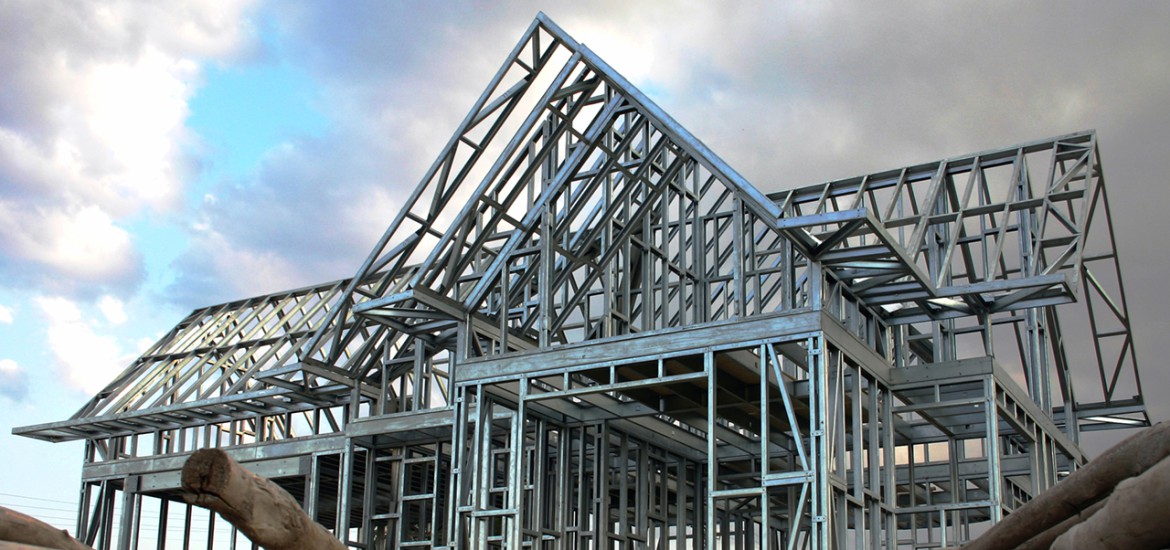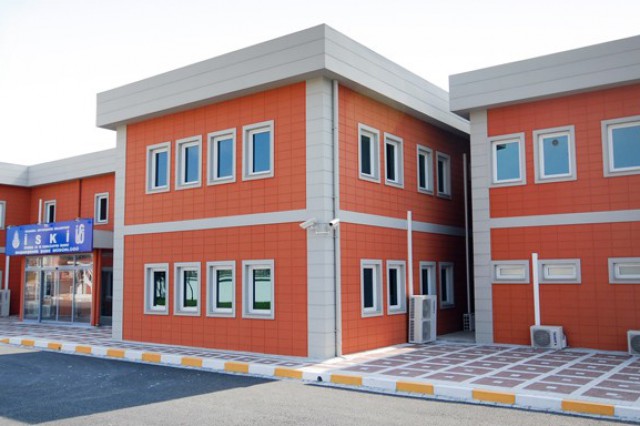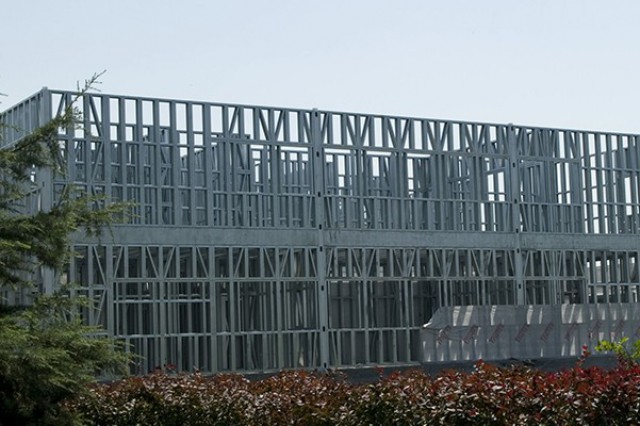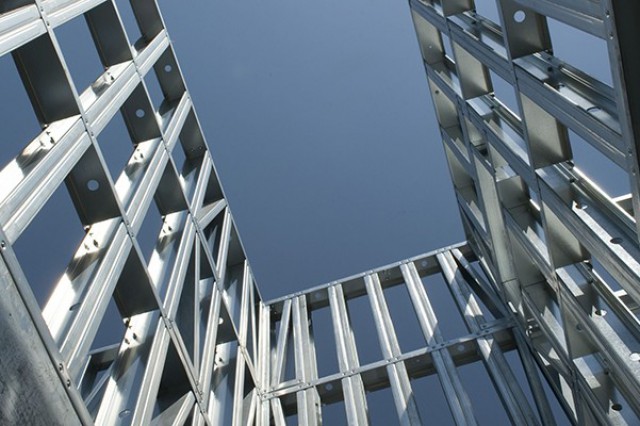Light Steel Building
Light Steel Structure SystemsLight steel is produced from galvanized steel by cold forming method.
Light steel construction technology is a construction system in which structural elements are produced from galvanized steel by cold forming method. Building details, which are structurally designed, are transferred to the machine with computer support and shaped in specially designed Hekim Structure Robot lines. Thanks to the fact that pre-manufacturing is carried out in the factory environment and on robot machine lines, errors that might be caused by human factor are minimized.
Light steel construction types are much more affordable compared to heavy steel and reinforced concrete, assembly and disassembly of the products can be performed easily. Construction machinery needed during the installation of heavy steel structures is not needed much for light steel structures. This is an important factor that reduces the installation cost even more.
Light Steel System Usage Areas
Light Steel Building Systems
Light gauge steel buildings stand out in modern construction with fast installation, long lifespan, and low maintenance costs. Offering high durability, energy efficiency, and modular design advantages, light steel frame building systems are ideal solutions for both residential and commercial structures. Building sustainable and cost-effective spaces has never been easier.
What Is a Light Steel Building?
A light steel building is a modern construction solution made from cold-formed steel sections that provide strength, flexibility, and sustainability. Unlike traditional heavy steel structures, light steel structure buildings are composed of thin-walled, galvanized steel profiles that are lightweight yet durable. These buildings are ideal for both residential and commercial applications, offering a balance of cost-efficiency and long-term performance.
The term light steel frame building refers to the modular nature of its components, which are prefabricated and then assembled on-site. This system accelerates the construction process while maintaining structural integrity. With evolving light gauge steel building technology, these structures are becoming increasingly popular across various sectors including housing, offices, and retail spaces.
Features of Light Steel Building Systems
Light gauge steel building systems are known for their precision-engineered components and adaptability in design. Each light gauge steel frame building construction involves elements that are manufactured off-site with advanced technology, ensuring uniformity and quality. These systems can accommodate architectural diversity while supporting heavy loads despite their lightweight nature.
The modular approach of building light gage steel module structure allows for quicker assembly, reduced labor costs, and minimal material waste. Most light steel building products are corrosion-resistant and require less maintenance over time. These features make them ideal for fast-track projects and sustainable development goals.
Installation Methods for Light Steel Building Systems
The construction of light steel framed buildings follows a standardized installation process, which greatly reduces on-site errors and construction time. Panels and frames are transported as prefabricated units, and then connected using screws, bolts, or welding methods depending on the project requirements. The use of light gauge steel frame buildings in modular construction allows easy scalability and modification.
Installation also includes integrated systems such as insulation, electrical layouts, and plumbing pre-installed within the frames. This minimizes disruptions and ensures faster project delivery. Thanks to modern light gauge steel building design practices, even complex structures can be executed with efficiency and accuracy.
Advantages of Using Light Steel Buildings
The use of light steel frame building systems provides numerous structural and economic advantages. One of the primary benefits is its rapid construction process, enabled by the prefabricated nature of components. This means projects using light gauge steel frame building construction can be completed in a fraction of the time compared to traditional building methods. Additionally, the steel used is 100% recyclable, making these systems an environmentally friendly choice.
Light steel building solutions also offer high strength-to-weight ratios, ensuring structural stability without the bulk. This enables architects and engineers to explore creative designs without compromising safety. As light gauge steel building technology continues to evolve, these systems are now recognized for their fire resistance, seismic performance, and adaptability to complex terrains and climates.
Low Maintenance Requirements
One of the standout benefits of light gauge steel buildings is their minimal need for maintenance. Galvanized and corrosion-resistant steel helps extend the building’s life span, reducing the cost and effort required for upkeep.
Resistance to Harsh Weather Conditions
Light steel frame buildings UK and worldwide are increasingly preferred in regions with challenging weather due to their resilience. The materials used resist moisture, wind, snow, and seismic activity, ensuring long-term safety and durability.
Common Usage Areas of Light Steel Buildings
Light steel building systems are versatile and used in a wide variety of sectors. In residential construction, they are ideal for housing projects, especially where rapid development and cost control are necessary. They are equally useful in commercial settings, including office buildings, retail spaces, and restaurants where flexible layout and fast build times are critical.
The strength and efficiency of light gauge steel frame buildings also make them popular in the industrial sector. Warehouses, storage facilities, and even educational buildings benefit from this technology. In many countries, especially in disaster-prone regions, the construction of light steel framed buildings is increasingly adopted for temporary shelters and emergency facilities due to their quick deployment capabilities.
Light Steel Buildings for Sale
If you’re considering investing in a light steel building, there are a wide variety of options on the market tailored to different needs and budgets. From small residential units to large-scale commercial solutions, the range of light steel building products continues to grow. These buildings are typically modular and customizable, making them a practical solution for various sectors.
When evaluating light weight steel frame buildings prices, it’s important to assess not just the base material cost, but also the included features like insulation, foundation compatibility, and customization options. Trusted providers often offer comprehensive packages that include light gauge steel building systems, installation guides, and customer support services to ensure a smooth process.
Light Steel Building Pricing
The cost of a light steel building can vary significantly depending on the size, design complexity, and the level of customization required. While initial prices might appear higher than traditional materials, the total cost of ownership is often lower due to faster construction, reduced labor needs, and minimal maintenance. This makes light weight steel frame buildings prices a competitive option in long-term investments.
Other pricing factors include insulation quality, wind and seismic resistance features, and the scope of prefabrication. Those investing in light gauge steel building systems benefit from predictable pricing thanks to modular design. Additionally, transportation and assembly costs are generally lower with these systems, making them attractive for both local and international buyers seeking efficient building solutions.
Things to Consider When Buying Light Steel Building Profiles
Choosing the right profiles is crucial in the construction of light steel framed buildings. You must assess not only the thickness and grade of steel but also its corrosion resistance, connection compatibility, and structural performance. Custom project needs—like specific loads, climatic conditions, or interior layouts—should be reflected in your profile selection.
Reliable suppliers of light steel building products often offer technical consultations and design support to ensure the selected system meets your architectural and engineering needs. Whether you’re buying for commercial use or residential development, ensure that the light gauge steel frame buildings you’re investing in comply with local building codes and sustainability requirements.
How to Order a Custom Light Steel Building System?
Ordering a customized light steel frame building begins with clearly defining your project scope. Start by selecting the size, structural layout, insulation needs, and intended usage of the building. Next, consult with a supplier or design firm specializing in light gauge steel building design to translate your requirements into technical specifications and drawings.
Once the design is approved, the manufacturing of components begins. These are produced according to light gauge steel building technology standards and delivered in prefabricated modules. The final step involves on-site installation by trained professionals who understand light gauge steel frame building construction. This approach ensures efficiency, quality control, and precise execution from concept to completion.
Key Considerations When Requesting Custom Building Panels
When requesting custom light steel building panels, always review panel thickness, galvanization levels, and thermal insulation properties. Your choices will impact structural durability and overall energy efficiency.
Maintenance and Longevity of Light Steel Buildings
One of the biggest advantages of light gauge steel buildings is their exceptional durability with minimal upkeep. Thanks to galvanized steel’s natural resistance to corrosion, moisture, and pests, the structure maintains its integrity for decades without requiring major repairs. This makes light steel structure buildings a low-maintenance investment that pays off over time.
The long life span of a light steel frame building is also supported by its resistance to common issues like cracking, warping, or rotting, which are typical in wood-based constructions. With regular inspections and minor touch-ups, a building created using light gauge steel frame building construction can serve reliably for over 50 years. This makes it ideal for both long-term personal use and commercial development projects.
Insulation and Energy Efficiency in Light Steel Buildings
Modern light steel building systems are designed with energy efficiency in mind. The steel frame itself allows for the integration of high-performance insulation materials between wall cavities. This setup helps regulate indoor temperatures, reduces reliance on heating and cooling systems, and results in lower energy bills. Especially in regions with extreme climates, this makes light gauge steel building technology a smart solution.
Proper insulation also contributes to noise reduction and improved interior comfort. As light gauge steel building design evolves, buildings are being equipped with eco-friendly features such as reflective coatings, insulated roof panels, and airtight construction methods. This ensures that both residential and commercial light steel frame buildings can meet or exceed modern energy standards.







